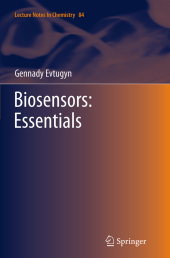 Neuerscheinungen 2016Stand: 2020-02-01 |
Schnellsuche
ISBN/Stichwort/Autor
|
Herderstraße 10
10625 Berlin
Tel.: 030 315 714 16
Fax 030 315 714 14
info@buchspektrum.de |

Gennady Evtugyn
Biosensors: Essentials
Softcover reprint of the original 1st ed. 2014. 2016. x, 265 S. 133 SW-Abb. 235 mm
Verlag/Jahr: SPRINGER, BERLIN; SPRINGER BERLIN HEIDELBERG 2016
ISBN: 3-662-50938-5 (3662509385)
Neue ISBN: 978-3-662-50938-8 (9783662509388)
Preis und Lieferzeit: Bitte klicken
Covering all the essentials from biochemical recognition to the latest MEMS systems, this book on biosensors and their applications includes a wealth of case studies. Written by a leading expert on the subject, it includes a chapter on likely future advances.
Today, biosensors are broadly applied in research, clinical diagnosis and monitoring, as well as in pharmaceutical, environmental or food analysis. In this work, the author presents the essentials that advanced students and researchers need to know in order to make full use of this technology. This includes a description of biochemical recognition
elements, such as enzymes, antibodies, aptamers or even whole cells. Various signal transducers such as electrochemical and optical transducers, luminescence devices and advanced techniques such as quartz crystal microbalances and MEMS systems are covered as well. Current applications are introduced through various case studies, rounded out by a forward-looking chapter on the prospects for biosensor development offered by nanotechnology, lab-on-a-chip, and biomimetic systems.
Introduction and Historic Overview.- Biochemical Components Used in Biosensor Assemblies: Enzymes.- Antibodies.- Protein / Peptide Receptors.- Nucleic Acids.- Whole Cells as Biosensing Elements.- Immobilization of Biochemical Elements of Biosensors.- Biosensor Signal Transducers: Electrochemical Transducers.- Optical Transducers.- Other Techniques.- How does it Work? - Case Studies.- Biosensors Prospects: Quo vadis? (Conclusion).
From the book reviews:
"This book is a useful introductory reading for undergraduate and graduate students, as well as for researchers in the related subjects of chemistry and biology ... . is well organized and covers the basic principles of biosensors, with emphasis on the main biological recognition elements and on the physical signal transducers used for the development of these devices, which are clearly and concisely described. ... a useful book for students and researchers interested in a general overview of this topic." (Marķa Cruz Moreno-Bondi, Analytical and Bioanalytical Chemistry, Vol. 406, October, 2014)


